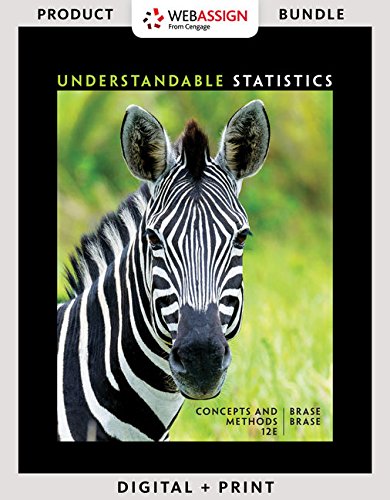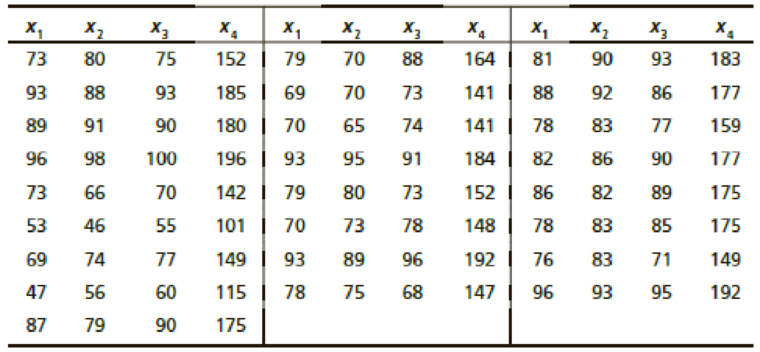
Concept explainers
For Problems 3-6, use appropriate multiple regression software of your choice and enter the data. Note that the data are also available for download at the Companion Sites for this text.
4. Education: Exam Scores Professor Gill has taught general psychology for many years. During the semester, she gives three multiple-choice exams, each worth 100 points. At the end of the course, Dr. Gill gives a comprehensive final worth 200 points. Let x1, x2, and x3 represent a student’s scores on exams 1, 2, and 3, respectively. Let x4 represent the student’s score on the final exam. Last semester Dr. Gill had 25 students in her class. The student exam scores are shown on the next page.

Since Professor Gill has not changed the course much from last semester to the present semester, the preceding data should be useful for constructing a regression model that describes this semester as well.
- (a) Generate summary statistics, including the
mean and standard deviation of each variable. Compute the coefficient of variation (see Section 3.2) for each variable. Relative to its mean, would you say that each exam had about the same spread of scores? Most professors do not wish to give an exam that is extremely easy or extremely hard. Would you say that all of the exams were about the same level of difficulty? (Consider both means and spread of test scores.) - (b) For each pair of variables, generate the sample
correlation coefficient r. Compute the corresponding coefficient of determination r2 Of the three exams 1,2, and 3, which do you think had the most influence on the final exam 4? Although one exam had more influence on the final exam, did the other two exams still have a lot of influence on the final? Explain each answer. - (c) Perform a
regression analysis with x4 as the response variable. Use x1 x2, and x3 as explanatory variables. Look at the coefficient of multiple determination. What percentage of the variation in x4 can be explained by the corresponding variations in x1 x2, and x3 taken together? - (d) Write out the regression equation. Explain how each coefficient can be thought of as a slope. If a student were to study "extra hard" for exam 3 and increase his or her score on that exam by 10 points, what corresponding change would you expect on the final exam? (Assume that exams I and 2 remain "fixed" in their scores.)
- (e) Test each coefficient in the regression equation to determine if it is zero or not zero. Use level of significance 5%. Why would the outcome of each hypothesis test help us decide whether or not a given variable should be used in the regression equation?
- (f) Find a 90% confidence interval for each coefficient.
- (g) This semester Susan has scores of 68, 72, and 75 on exams 1, 2, and 3, respectively. Make a prediction for Susan’s score on the final exam and find a 90% confidence interval for your prediction (if your software supports prediction intervals).
Want to see the full answer?
Check out a sample textbook solution
Chapter 9 Solutions
Bundle: Understandable Statistics: Concepts And Methods, 12th + Jmp Printed Access Card For Peck's Statistics + Webassign Printed Access Card For ... And Methods, 12th Edition, Single-term
- A marketing agency wants to determine whether different advertising platforms generate significantly different levels of customer engagement. The agency measures the average number of daily clicks on ads for three platforms: Social Media, Search Engines, and Email Campaigns. The agency collects data on daily clicks for each platform over a 10-day period and wants to test whether there is a statistically significant difference in the mean number of daily clicks among these platforms. Conduct ANOVA test. You can provide your answer by inserting a text box and the answer must include: also please provide a step by on getting the answers in excel Null hypothesis, Alternative hypothesis, Show answer (output table/summary table), and Conclusion based on the P value.arrow_forwardA company found that the daily sales revenue of its flagship product follows a normal distribution with a mean of $4500 and a standard deviation of $450. The company defines a "high-sales day" that is, any day with sales exceeding $4800. please provide a step by step on how to get the answers Q: What percentage of days can the company expect to have "high-sales days" or sales greater than $4800? Q: What is the sales revenue threshold for the bottom 10% of days? (please note that 10% refers to the probability/area under bell curve towards the lower tail of bell curve) Provide answers in the yellow cellsarrow_forwardBusiness Discussarrow_forward
- The following data represent total ventilation measured in liters of air per minute per square meter of body area for two independent (and randomly chosen) samples. Analyze these data using the appropriate non-parametric hypothesis testarrow_forwardeach column represents before & after measurements on the same individual. Analyze with the appropriate non-parametric hypothesis test for a paired design.arrow_forwardShould you be confident in applying your regression equation to estimate the heart rate of a python at 35°C? Why or why not?arrow_forward
 Functions and Change: A Modeling Approach to Coll...AlgebraISBN:9781337111348Author:Bruce Crauder, Benny Evans, Alan NoellPublisher:Cengage Learning
Functions and Change: A Modeling Approach to Coll...AlgebraISBN:9781337111348Author:Bruce Crauder, Benny Evans, Alan NoellPublisher:Cengage Learning Glencoe Algebra 1, Student Edition, 9780079039897...AlgebraISBN:9780079039897Author:CarterPublisher:McGraw Hill
Glencoe Algebra 1, Student Edition, 9780079039897...AlgebraISBN:9780079039897Author:CarterPublisher:McGraw Hill Algebra and Trigonometry (MindTap Course List)AlgebraISBN:9781305071742Author:James Stewart, Lothar Redlin, Saleem WatsonPublisher:Cengage Learning
Algebra and Trigonometry (MindTap Course List)AlgebraISBN:9781305071742Author:James Stewart, Lothar Redlin, Saleem WatsonPublisher:Cengage Learning
 Holt Mcdougal Larson Pre-algebra: Student Edition...AlgebraISBN:9780547587776Author:HOLT MCDOUGALPublisher:HOLT MCDOUGAL
Holt Mcdougal Larson Pre-algebra: Student Edition...AlgebraISBN:9780547587776Author:HOLT MCDOUGALPublisher:HOLT MCDOUGAL Linear Algebra: A Modern IntroductionAlgebraISBN:9781285463247Author:David PoolePublisher:Cengage Learning
Linear Algebra: A Modern IntroductionAlgebraISBN:9781285463247Author:David PoolePublisher:Cengage Learning





